In times of war, trauma and major disruption, the mind retreats and there appears to be much splitting. The world has fractured into binaries: victim or perpetrator, freedom or terror, good or evil, because nuance is too painful to hold. And so the ‘Third’ is lost.
Jung called the Third the transcendent function: the symbolic space where opposites meet, wrestle, and give birth to new meaning. But in our time, it appears to be a forgotten idea and something unbearable to address. The collective is not sitting in comfort with paradox, or at least not for long. The human psyche is reaching for clarity and social media and the online world allows for concrete answers to be found, even if they amputate empathy to get there.
It appears that we are stuck in a birth canal of collective pain. The contractions are global, the crowning is obstructed, and the baby that longs to be born is not a winner. However this metaphorical baby is a symbol, a potential bridge: a Third. The Third is the space where grief meets dignity.
The psyche, unable to metabolise such suffering, splits. People become symbols and camps form. “Free Gaza” becomes a chant and “Bring them home” becomes a plea. But few can hold both. Fewer still dare to speak into the fracture with love. And there is a danger in this, and that is not the danger of disagreement, it is the danger of disembodiment. The danger is when slogans and ideas replace fleshy sorrow. When the mind splits off from the body and ideology overrides humanity. When one form of suffering must disappear in order for another to be seen.
Marx warned us of alienation, not just from labour, but from self, from others, from meaning. Under capitalism, identities become tools, and people become categories. The 'isms' ; nationalism, colonialism, even activism when untethered from soul, risk becoming mechanisms of disconnection, however righteous their origin. When human beings are flattened into ideological positions, we lose the possibility of encounter.
Emmanuel Levinas reminds us that ethics begins in the face of the other, not in a theory, but in the gaze. When we meet the other’s eyes, and allow ourselves to be undone by their presence, something sacred happens. We are called into responsibility, not dominance. And yet our eyes are turned away, either from hostages or from bombed children, and even the grief in our own communities. The gaze has been replaced with scrolling, slogans, and shame.
This is a Chironian time, this planet is retrograde until January 2026. Chiron, the wounded healer, limps through the house of language. He does not speak in solutions, but in gestures. He listens for what cannot be said and translates rupture into meaning, but only if the wound is honoured.
In my own chart, Chiron lives in the third house. The house of voice, writing, connection, and learning. For me, the wound is in communication itself: how to speak, how to listen, how to be heard when speech is dangerous. During this retrograde, the wound speaks again. And I am learning, once more, that healing may not be about finding the right words or the convincing argument. But deep wounds, whether personal or collective, cannot always be put into tidy sentences. Sometimes, healing is not about finding the right words; it is about becoming a vessel for them.
Dr Demeter sitting with Yarrow on Magical Farm
To become a vessel means to open yourself fully, to hold space for what is too painful, complex, or ambiguous to be spoken clearly. It means allowing emotions, truths, and contradictions to flow through you without forcing control or closure. In this space, words become less important than presence, the act of listening deeply and holding the unspoken with compassion.
This kind of healing invites transformation not through intellectual mastery but through embodied receptivity. It creates a container where fractured parts can meet, where paradox can live, and where new meaning can emerge beyond language. In the context of conflict and division, this vessel-like listening becomes a radical act. It allows voices from all sides especially those silenced or marginalised to be heard, not as arguments to win but as human stories to hold with care.
Introducing, Yarrow the Integrator
Beside Chiron, there grows yarrow, achillea millefolium a variety I grow on my farm, where the soil is intelligent and the herbs speak back. The botanical name reminds us of Achilles, the warrior of myth whose only vulnerable spot was his heel. It was Chiron, the wounded healer and teacher who tended Achilles’ wound with yarrow, the plant of healing and integration.
This ancient myth is a poetic mirror for our times. Like Achilles, we carry wounds that feel both mortal and isolating. Like Chiron, healing is not about erasing pain but honouring it and allowing it to become a doorway. Yarrow stands at that threshold, a living symbol of how vulnerability and strength, pain and wholeness, can coexist.
Yarrow is a plant of integration. It grows in disturbed ground. It draws the borders and softens them. It is both shield and salve. They say yarrow stops bleeding, but it also helps the soul hold contradiction. It belongs to Venus as much as to Chiron. Venus, too, is a planetary bridge, often misunderstood as frivolous, she is in fact the ruler of value, of relatedness, of aesthetic order. Venus seeks harmony not through denial, but through composition and deep reflection. Venus does not choose sides, but she creates the pattern that allows both to be seen.
So I say this seriously, not metaphorically: activists, intellectuals, policy writers, poets, drink yarrow tea! Or take a drop of the essence I make on my farm. Yarrow will not give you answers. But it may help your body hold the question long enough for something new, something reconciliatory to root, individually and collectively.
Because the world does not need more conclusions, it needs more containers. Places where grief and truth can co-exist without annihilating one another. Places where the Third can return.
And we need visions, which are the manifestations of integration. We need clear design scenarios of integration. There is great power of imagination, as Einstein reminded us, is more important than knowledge. Rudolf Steiner said imagination is not fantasy, but a perceptive organ, one we must cultivate for the health of our social body. It is imagination that allows us to see possibility beyond destruction, futures that are relational, not adversarial.
Today, imagination is underused. Not in the sense of creativity for art alone, but as a collective spiritual function. The ability to picture integration and to see Israelis and Palestinians weeping together, rebuilding together, sharing land and water and myth, is not utopian. It is necessary. And there are those who already carry these images. Not loudly, not always with hashtags. But in kitchens, fields, synagogues, mosques, community centres. Unseen groups, holding grief and tending complexity. They are the seeds of a Third way.
The Missing Bridge: Between Inner Integration and Outer Systems
So in conclusion, the conversations about healing, reconciliation, and the collective trauma of conflict, we often emphasise the need to hold paradox, to embrace complexity, to create the “Third” which is that symbolic space where opposing truths can coexist without annihilating one another. This inner work of psychic integration is vital. Yet, it often feels like a fragile offering when faced with the brutal realities of systemic violence, occupation, and injustice.
There is a yawning gap between the symbolic and the systemic, between the deep psychic healing the world needs and the urgent political and material changes that must occur. The collective unconscious expresses itself not only in myths and archetypes but through laws, borders, economic structures, and power imbalances. The systems of occupation, dispossession, and inequality shape what can be felt, acknowledged, and transformed within the psyche. At the same time, the wounds within the psyche, fear, hatred, alienation, sustain and regenerate these very systems.
To imagine a future beyond division, we must bridge this gap. Healing cannot be only a spiritual or symbolic exercise divorced from the hard, embodied work of dismantling systemic violence and injustice. Nor can political change succeed without attending to the psychic wounds that entrench separation and projection.
If we are to be midwives to the symbolic child yearning to be born, a new paradigm humans can find shared ground then our healing must be both systemic and symbolic. We must tend the wounds of history and psyche with fierce love, while also dismantling the structures that inflict those wounds.
The missing bridge, the ‘Third’ is the holding space where inner transformation meets outer justice. It is where grief meets action, where sorrow meets accountability, where memory meets imagination. It is neither abstract nor distant. It is the difficult, necessary work of being fully human in a fractured world.
Drawing on Arturo Escobar’s Designs for the Pluriverse, I want to be clear: I am midwifing an idea for an emergence, even if this piece of writing contibutes to the morphic field, as a way of a nudge. In the midst of pain, I seek to hold space for integration. Escobar reminds us that pluriversal design is not about flattening difference, but about making room for many worlds to co-exist. In this spirit, the imaginal Third I speak of is not a compromise, but a commitment to the complexity of life, to what might yet be born when we stop insisting on a single truth.
In reality, this is already the emerging reality: coexistence, compromise, and the weaving together of many worlds, many truths, and many lives. This is not only the task for Israel and Palestine it is the task of life in our complex, interconnected world. Moving beyond binaries and polarisation requires not just intellect, but presence, oral story, phenomenological being, embodied imagination.
Let us listen to them. Let us look at one another. Let us imagine what integration tastes like, sounds like, grows like. Let us be midwives to the symbolic child who wants to be born.
✨ Magical Farm Yarrow ‘Acelia’ Essence
For the courage to stand in the space-between and weave what has been split. This gentle yet powerful ally protects the heart while allowing grief, love, and truth to meet without collapsing into either/or. Take it as a bridge between your wound and your voice, so what cannot be spoken finds a way to be heard. Interested in working with the yarrow flower essence mentioned here? Visit https://magicalfarm.org/herbs-floweressences/yarrow-flower-essence or get in touch via info@magicalfarm.org.



